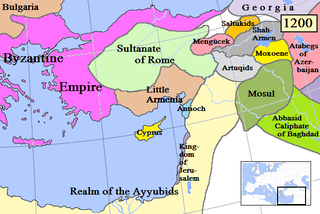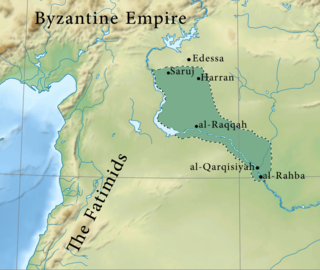
Al-Nasir Salah al-Din Yusuf ibn Ayyub, better known simply as Salah ad-Din or Saladin, was a Sunni Muslim Kurd who became the first sultan of both Egypt and Syria, and was the founder of the Ayyubid dynasty. Saladin led the Muslim military campaign against the Crusader states in the Levant. He was an important figure in the Third Crusade. At the height of his power, his sultanate spanned Egypt, Syria, Upper Mesopotamia (Iraq), the Hejaz, Yemen, parts of western North Africa, and Nubia.

The Ayyubid dynasty was the founding dynasty of the medieval Sultanate of Egypt established by Saladin in 1171, following his abolition of the Fatimid Caliphate of Egypt. A Sunni Muslim of Kurdish origin, Saladin had originally served Nur ad-Din of Syria, leading Nur ad-Din's army in battle against the Crusaders in Fatimid Egypt, where he was made Vizier. Following Nur ad-Din's death, Saladin was proclaimed as the first Sultan of Egypt, and rapidly expanded the new sultanate beyond the frontiers of Egypt to encompass most of the Levant, in addition to Hijaz, Yemen, northern Nubia, Tarabulus, Cyrenaica, southern Anatolia, and northern Iraq, the homeland of his Kurdish family. By virtue of his sultanate including Hijaz, the location of the Islamic holy cities of Mecca and Medina, he was the first ruler to be hailed as the Custodian of the Two Holy Mosques, a title that would be held by all subsequent Sultans of Egypt until the Ottoman conquest of 1517. Saladin's military campaigns in the first decade of his rule, aimed at uniting the various Arab and Muslim states in the region against the Crusaders, set the general borders and sphere of influence of the Sultanate of Egypt for the almost three and a half centuries of its existence. Most of the Crusader states, including the Kingdom of Jerusalem, fell to Saladin after his victory at the Battle of Hattin in 1187. However, the Crusaders reconquered the coast of Palestine in the 1190s.

The Zengid or Zangid dynasty was a Muslim dynasty of Oghuz Turkic origin, which ruled parts of the Levant and Upper Mesopotamia on behalf of the Seljuk Empire. The dynasty was founded by Imad ad-Din Zengi.

Imad al-Din Zengi, also romanized as Zangi, Zengui, Zenki, and Zanki, was a Turk who ruled Mosul, Aleppo, Hama, and, later, Edessa. He was the namesake of the Zengid dynasty.
Abu Sa'id Taj al-Dawla Tutush or Tutush I, was the Seljuk emir of Damascus from 1078 to 1092, and sultan of Damascus from 1092 to 1094.
Abu Said Aq Sunqur al-Hajib was the Seljuk governor of Aleppo under Sultan Malik Shah I. He was considered the de facto ruler of most of Syria from 1087. He was beheaded in 1094 following accusations of treason by Tutush I, the ruler of Damascus.
Ridwan was a Seljuk emir of Aleppo from 1095 until his death.

The Artuqid dynasty was a Turkoman dynasty originated from Döğer tribe that ruled in eastern Anatolia, Northern Syria and Northern Iraq in the eleventh through thirteenth centuries. The Artuqid dynasty took its name from its founder, Artuk Bey, who was of the Döger branch of the Oghuz Turks and ruled one of the Turkmen beyliks of the Seljuk Empire. Artuk's sons and descendants ruled the three branches in the region: Sökmen's descendants ruled the region around Hasankeyf between 1102 and 1231; Ilghazi's branch ruled from Mardin and Mayyafariqin between 1106 and 1186 and Aleppo from 1117–1128; and the Harput line starting in 1112 under the Sökmen branch, and was independent between 1185 and 1233.
As-Salih Ismaʿil al-Malik (1163–1181) was an emir of Damascus and emir of Aleppo in 1174, the son of Nur ad-Din.
Muʿizz al-Dawla Abū ʿUlwān Thimāl ibn Ṣāliẖ ibn Mirdās was the Mirdasid emir of Aleppo from 1042 until 1057, and again from 1061 until his death. He was the son of Salih ibn Mirdas.

Abu Kamil Nasr ibn Salih ibn Mirdas, also known by his laqab of Shibl al-Dawla, was the second Mirdasid emir of Aleppo, ruling between 1029/1030 until his death. He was the eldest son of Salih ibn Mirdas, founder of the Mirdasid dynasty. Nasr fought alongside his father in the battle of al-Uqhuwana near Tiberias, where Salih was killed by a Fatimid army led by Anushtakin al-Dizbari. Afterward, Nasr ruled the emirate jointly with his brother Thimal. The young emirs soon faced a large scale Byzantine offensive led by Emperor Romanos III. Commanding a much smaller force of Bedouin horsemen, Nasr routed the Byzantines at the Battle of Azaz.
Izz al-Din Mas'ud (I) ibn Mawdud was a Zengid emir of Mosul.
Kafartab was a town and fortress in northwestern Syria that existed during the medieval period between the fortress cities of Maarat al-Numan in the north and Shaizar to the south. It was situated along the southeastern slopes of Jabal al-Zawiya. According to French geographer Robert Boulanger, writing in the early 1940s, Kafartab was "an abandoned ancient site" located 2.5 mi (4.0 km) northwest of Khan Shaykhun.
Rashid al-Dawla Mahmud, full name Mahmud bin Shibl al-Dawla Nasr bin Salih bin Mirdas also known as Abu Salama Mahmud bin Nasr bin Salih, was the Mirdasid emir of Aleppo from 1060 to 1061 and again from 1065 until his death.

Al-Rahba, also known as Qal'at al-Rahba, which translates as the "Citadel of al-Rahba", is a medieval Arab fortress on the west bank of the Euphrates River, adjacent to the city of Mayadin in Syria. Situated atop a mound with an elevation of 244 meters (801 ft), al-Rahba oversees the Syrian Desert steppe. It has been described as "a fortress within a fortress"; it consists of an inner keep measuring 60 by 30 meters, protected by an enclosure measuring 270 by 95 meters. Al-Rahba is largely in ruins today as a result of wind erosion.

The Numayrids were an Arab dynasty based in Diyar Mudar. They were emirs (princes) of their namesake tribe, the Banu Numayr. The senior branch of the dynasty, founded by Waththab ibn Sabiq in 990, ruled the Euphrates cities of Harran, Saruj and Raqqa more or less continuously until the late 11th century. In the early part of Waththab's reign, the Numayrids also controlled Edessa until the Byzantines conquered it in the early 1030s. In 1062, the Numayrids lost Raqqa to their distant kinsmen and erstwhile allies, the Mirdasids, while by 1081, their capital Harran and nearby Saruj were conquered by the Turkish Seljuks and their Arab Uqaylid allies. Numayrid emirs continued to hold isolated fortresses in Upper Mesopotamia, such as Qal'at an-Najm and Sinn Ibn Utayr near Samosata until the early 12th century, but nothing is heard of them after 1120.
Irtash was a Seljuk emir of Damascus in 1104. Irtash was born to Taj ad-Dawla Tutush, the brother of the Seljuk Sultan Malik-Shah I who established a principality in Syria after his brother gave the region and the adjacent areas to him. Following the death of Malik-Shah, Tutush claimed the Seljuk crown, but he was killed by the forces of his nephew Berkyaruq near Ray. Subsequently, Irtash's brother Ridwan moved to Aleppo and proclaimed himself the new emir. Irtash's other brother Duqaq's declaration of a new emirate in Damascus separated the Syrian Seljuk state into two and started a rivalry between the two brothers. Duqaq then imprisoned Irtash for nine years in Baalbek.
Husam al-Din Timurtash was an Artuqid emir of Mardin (1122–1154) and ruler of Aleppo (1124–1125).



























